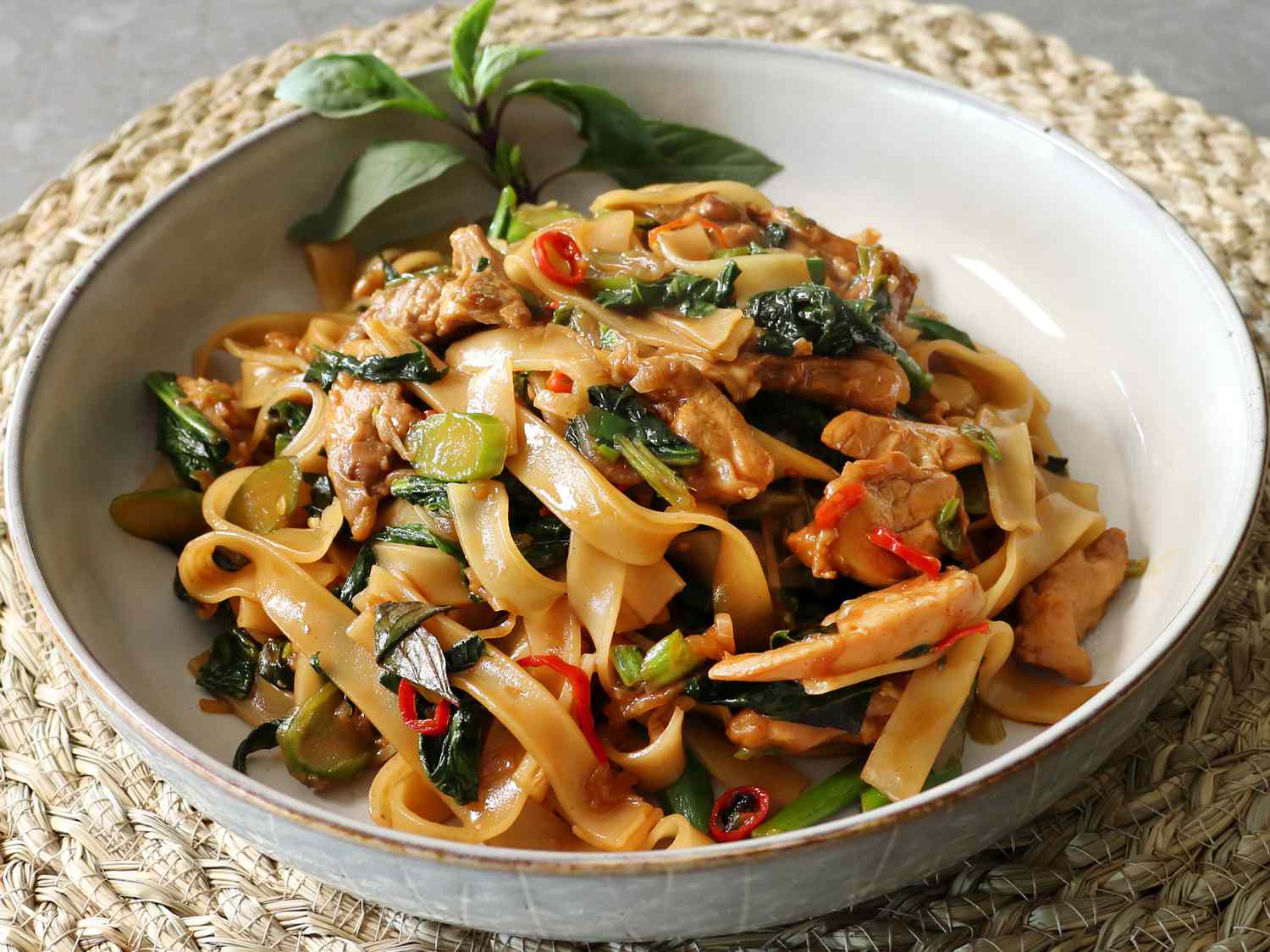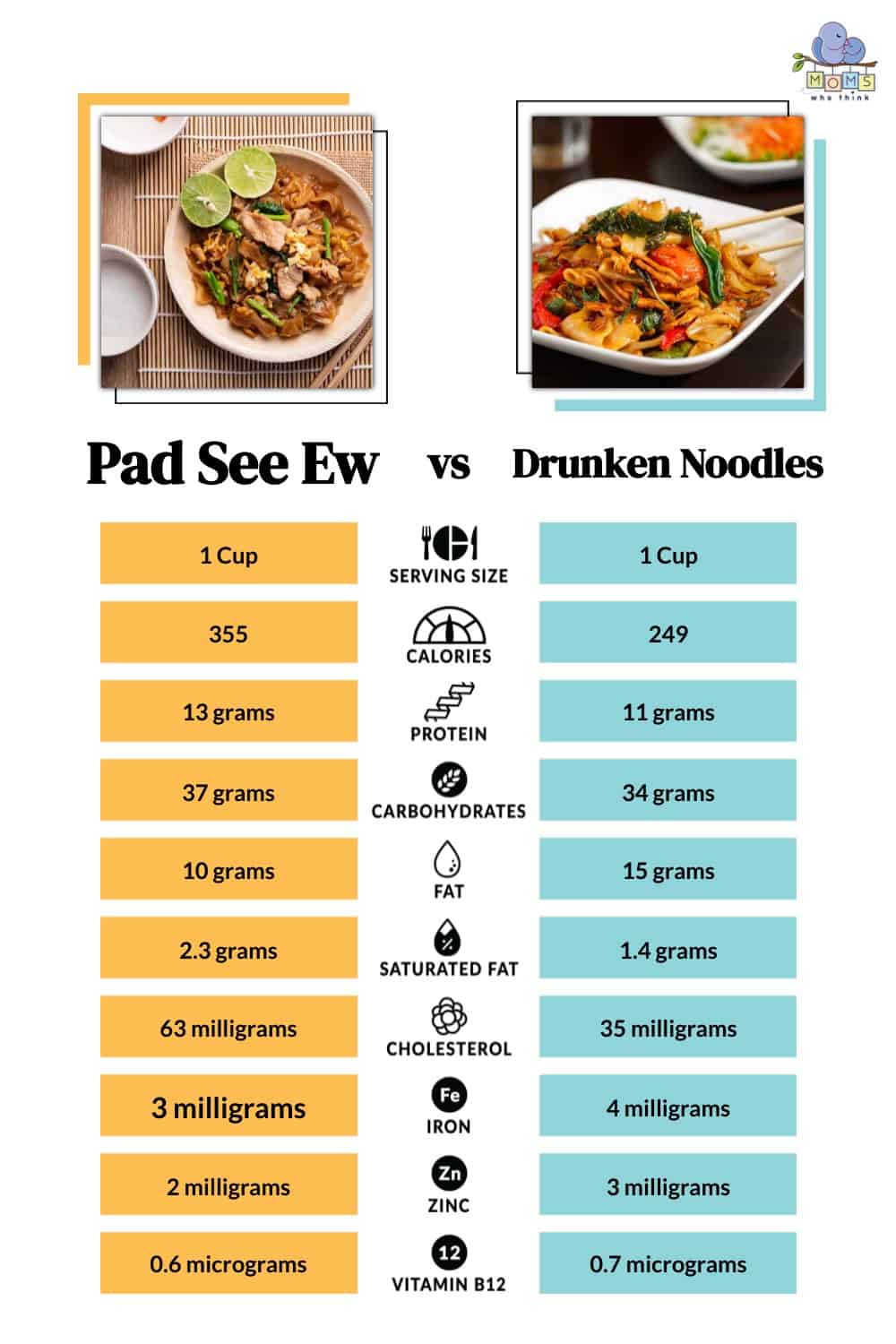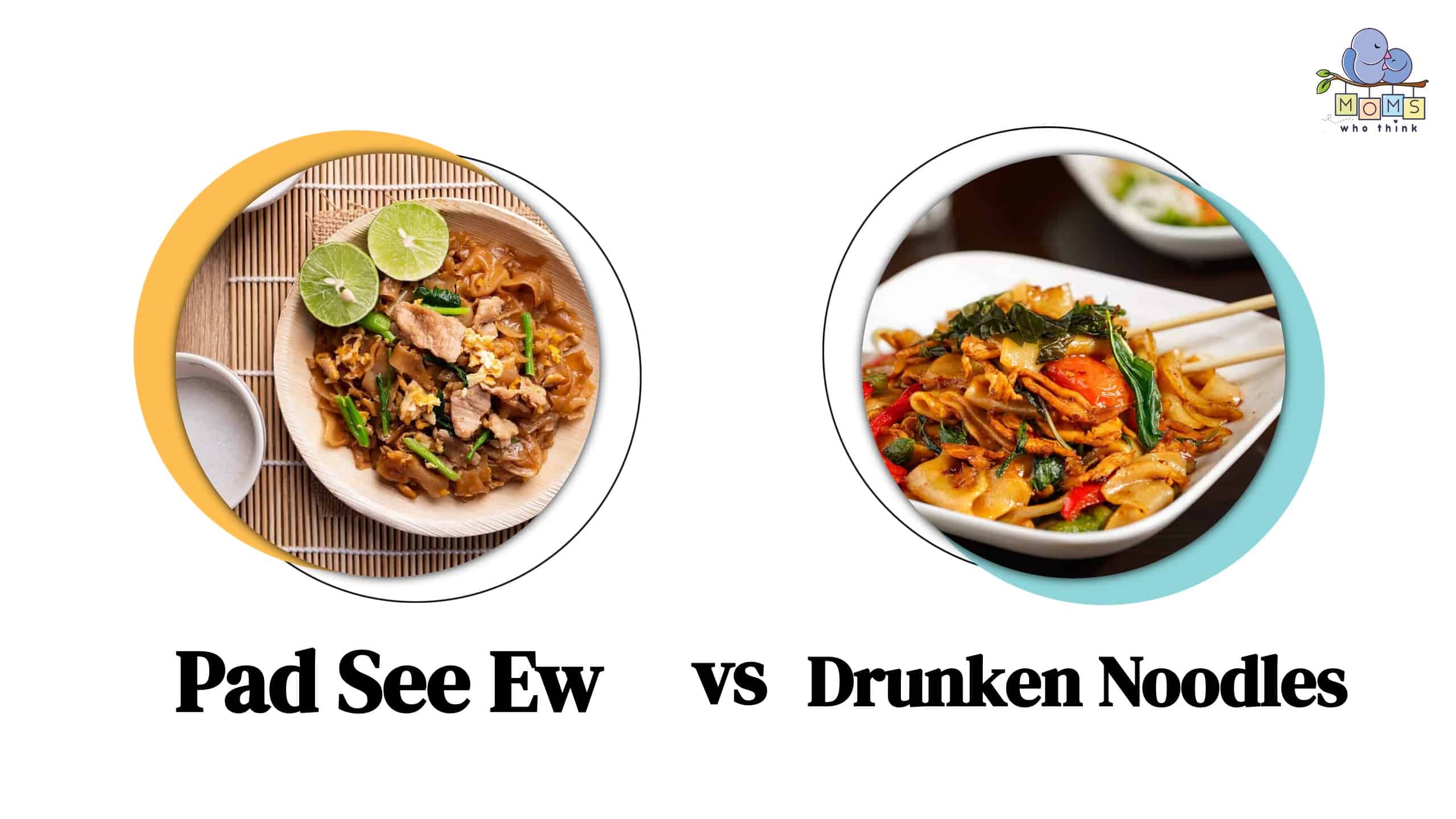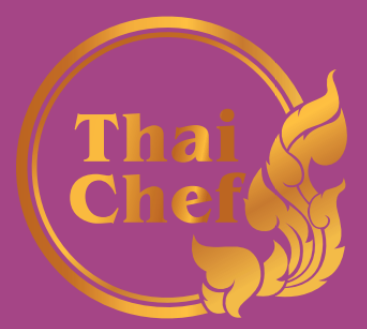Introduction
The Popularity Of Thai Noodles: Pad Thai Vs Drunken Noodles
Thai cuisine is known for its vibrant and bold flavors, and noodles play a significant role in this culinary tradition. Among the various Thai noodle dishes, Pad Thai and Drunken Noodles are two favorites that are widely enjoyed by people around the world. While these dishes may appear similar at first glance, they have distinct characteristics that set them apart. Understanding the key differences in taste and ingredients can help you make an informed choice when ordering your next Thai meal.
Understanding The Key Differences In Taste And Ingredients
One of the primary ways in which Pad Thai and Drunken Noodles differ is in their flavor profiles. Pad Thai is known for its sweeter and nuttier taste, while Drunken Noodles offer a more flavorful and spicy experience. The sweetness in Pad Thai comes from the use of tamarind paste, which also provides a tangy element to the dish. On the other hand, Drunken Noodles derive their spiciness from chili peppers and Thai basil, creating a spicy and aromatic combination.
When it comes to ingredients, both dishes use rice noodles as the base. However, there are some slight variations. Pad Thai typically uses thinner rice sticks, giving it a lighter texture, while Drunken Noodles use wider rice noodles that have a chewier consistency. Additionally, Pad Thai often includes ingredients like shrimp, tofu, crushed peanuts, bean sprouts, and eggs, creating a balanced mix of flavors and textures. Drunken Noodles, on the other hand, may consist of ingredients like chicken, beef, or seafood, along with Thai basil, bell peppers, onions, and chili peppers, resulting in a more robust and savory taste.
In conclusion, although both Pad Thai and Drunken Noodles are delicious Thai noodle dishes, they offer distinct flavors and ingredients. Pad Thai is sweeter and nuttier, while Drunken Noodles are spicier and more flavorful. Whichever dish you choose, you can be sure to enjoy a delectable and satisfying Thai meal.

Pad Thai: The National Dish Of Thailand
Exploring The History And Cultural Significance Of Pad Thai
Pad Thai holds a special place in Thai cuisine as it is considered the national dish of Thailand. Its origins can be traced back to the 1930s when the Thai government introduced a campaign to promote domestic food consumption. The dish was created as a way to incorporate traditional Thai flavors with the influence of Chinese stir-fry techniques.
Key Ingredients And Flavor Profile Of Pad Thai
Pad Thai is characterized by its bold umami flavors and vibrant taste. The dish typically consists of thinner rice noodles that are stir-fried with a combination of ingredients. The key components include:
- Proteins: Pad Thai often includes proteins such as shrimp, tofu, or chicken. These proteins add a savory element to the dish and enhance the overall flavor.
- Aromatics: Garlic and shallots are commonly used in Pad Thai to provide a fragrant base for the dish. These aromatics add depth of flavor and enhance the overall taste.
- Tamarind paste: One of the defining ingredients in Pad Thai is tamarind paste, which provides a sweet and tangy flavor. It adds a pleasant acidity to balance out the other flavors in the dish.
- Fish sauce: Fish sauce is a staple in Thai cuisine and is used in Pad Thai to add a distinctive umami taste. It acts as a seasoning and enhances the overall savory profile of the dish.
- Garnishes: To complete the dish, Pad Thai is often garnished with crushed peanuts, bean sprouts, and lime wedges. These garnishes add crunch, freshness, and acidity to the final presentation.
The combination of these ingredients creates a harmonious balance of flavors in Pad Thai, with a perfect blend of sweetness, umami, and tanginess. It is no wonder that Pad Thai has become a favorite among Thai food enthusiasts worldwide.
Overall, Pad Thai is a quintessential Thai dish that embodies the rich culinary traditions of Thailand. Its history, cultural significance, and distinct flavors make it a beloved choice for Thai food lovers everywhere. Whether you prefer the sweeter profile of Pad Thai or the spicier experience of Drunken Noodles, both dishes offer a delightful and satisfying Thai dining experience.
Origins And Unique Characteristics Of Drunken Noodles
Drunken Noodles, also known as Pad Kee Mao, is another popular Thai dish that has gained recognition for its bold flavors and spicy kick. While not as widely recognized as Pad Thai, Drunken Noodles has its own unique origins and characteristics.
Drunken Noodles is believed to have originated in central Thailand, particularly in the street food stalls of Bangkok. The dish got its name because it was often enjoyed with a cold beer, making it a popular choice for late-night snacking. As for its unique characteristics, Drunken Noodles typically consists of wide rice noodles stir-fried with various proteins and vegetables.
The dish is known for its rich, savory sauce, which is packed with delicious spices and Thai Basil. The addition of Thai Basil gives Drunken Noodles a distinctive taste and contributes to its overall spiciness. The sauce is often made with a combination of ingredients such as soy sauce, oyster sauce, garlic, chili peppers, and sugar. This blend of flavors creates a complex and satisfying taste that sets Drunken Noodles apart from other Thai dishes.
Spices And Heat Levels In Drunken Noodles
One of the key differences between Pad Thai and Drunken Noodles is the level of spiciness. Drunken Noodles is known for its fiery heat, while Pad Thai tends to have a milder flavor profile. The spiciness in Drunken Noodles comes from the use of chili peppers, which are typically added to the dish during the cooking process. The heat level can vary depending on personal preferences, but Drunken Noodles is generally considered a spicy dish.
In terms of proteins, Drunken Noodles can be prepared with a variety of options, including tofu, chicken, beef, or other darker meats. The choice of protein adds another layer of flavor to the dish, allowing individuals to customize it according to their preferences.
Overall, Drunken Noodles offers a different flavor experience compared to Pad Thai. Its spiciness, savory sauce, and distinct blend of spices make it a favorite among those who enjoy bold and spicy Thai cuisine. Whether you prefer the traditional flavors of Pad Thai or the fiery sensation of Drunken Noodles, both dishes provide an authentic taste of Thailand that is sure to satisfy any Thai food lover.
Ingredients Comparison
Contrasting The Ingredients Used In Pad Thai And Drunken Noodles
When comparing the ingredients used in Pad Thai and Drunken Noodles, it becomes apparent that these two dishes differ significantly in terms of flavor profiles and components.
Pad Thai:
- The main ingredients in Pad Thai include rice noodles, bean sprouts, eggs, tofu or shrimp, green onions, and crushed peanuts.
- The flavor of Pad Thai is typically a balance between sweet, sour, and tangy, thanks to the combination of tamarind paste, fish sauce, lime juice, and palm sugar.
- Additional ingredients, such as garlic, shallots, dried shrimp, and dried chili flakes, are often added to enhance the taste.
Drunken Noodles:
- Drunken Noodles feature wide rice noodles, Thai Basil, and a variety of proteins and vegetables.
- The dish is known for its rich and savory sauce, which is made with a combination of soy sauce, oyster sauce, garlic, chili peppers, and sugar.
- The use of Thai Basil gives Drunken Noodles a distinctive taste and contributes to its overall spiciness.
The Role Of Rice Noodles, Protein, And Vegetables
Rice Noodles:
- Both Pad Thai and Drunken Noodles use rice noodles as their base. These noodles provide a chewy texture and soak up the flavors of the dishes.
- Despite the similarity in noodle type, the thickness of the rice noodles can differ between the two dishes, with Drunken Noodles often using wider noodles compared to Pad Thai.
Protein:
- Pad Thai traditionally includes tofu and/or shrimp as the protein options, while Drunken Noodles allow for more variety, including tofu, chicken, beef, or other darker meats.
- The choice of protein adds depth and a satiating element to both dishes, allowing individuals to customize their meals according to their preferences.
Vegetables:
- Bean sprouts, green onions, and peanuts are commonly used in Pad Thai to provide crunch and freshness.
- Drunken Noodles often include a combination of vegetables such as bell peppers, onions, and carrots, which add both flavor and texture to the dish.
In summary, while both Pad Thai and Drunken Noodles feature rice noodles as their base, the ingredients used and the flavor profiles differ significantly. Pad Thai offers a balance between sweet, sour, and tangy flavors, while Drunken Noodles provide a bold and spicy experience with its rich and savory sauce. Whether you prefer the milder and tangy flavors of Pad Thai or the fiery sensation of Drunken Noodles, both dishes offer a delicious taste of Thai cuisine.

Flavor Profiles
The Distinctive Flavors Of Pad Thai And Drunken Noodles
When it comes to flavor, Pad Thai and Drunken Noodles offer distinct taste experiences. Pad Thai is known for its balance of sweet, sour, and tangy flavors, resulting from the combination of tamarind paste, fish sauce, lime juice, and palm sugar. On the other hand, Drunken Noodles deliver a bold and spicy experience with its rich and savory sauce made from soy sauce, oyster sauce, garlic, chili peppers, and sugar. Additionally, the use of Thai Basil in Drunken Noodles adds a unique taste and contributes to its overall spiciness.
Sweetness, Tanginess, And Levels Of Spiciness
In terms of sweetness, Pad Thai leans towards a sweeter profile due to the presence of palm sugar, balancing the tanginess from the tamarind. This creates a harmonious blend of flavors. Meanwhile, Drunken Noodles offer a combination of sweetness and spiciness that creates a fiery sensation on the palate. The use of chili peppers and soy sauce in the sauce adds a level of heat that can be customized to individual preferences.
While both dishes offer a delightful explosion of flavors, Pad Thai and Drunken Noodles cater to different taste preferences. Pad Thai appeals to individuals who enjoy the interplay between sweet, sour, and tangy flavors, providing a milder yet fulfilling taste. On the other hand, Drunken Noodles satisfy those who crave a bolder, spicier experience, making it the perfect choice for those who enjoy a little heat.
In conclusion, whether you prefer the balanced and tangy flavors of Pad Thai or the bold and spicy punch of Drunken Noodles, both dishes are exceptional choices to explore the diverse flavors of Thai cuisine.
Cooking Techniques
Different Cooking Methods For Pad Thai And Drunken Noodles
When it comes to cooking techniques, Pad Thai and Drunken Noodles differ in their approach. Pad Thai is typically stir-fried, a method that involves quickly cooking the noodles and ingredients over high heat in a wok or skillet. This technique allows the flavors to meld together while maintaining the texture of the noodles. On the other hand, Drunken Noodles are commonly boiled or blanched before being stir-fried. Boiling the noodles first ensures they are fully cooked and tender before they are added to the wok for stir-frying.
Stir-frying Vs Boiling: Impact On Taste And Texture
The choice of cooking method greatly affects the taste and texture of the final dish. Stir-frying the noodles in Pad Thai creates a slightly crispy texture on the outside while keeping them soft and chewy on the inside. The quick cooking process also helps to retain the freshness and individual flavors of the ingredients. In contrast, the boiling technique used for Drunken Noodles results in a softer and more tender noodle texture that absorbs the flavors of the sauce during the stir-frying process. This method allows the flavors to penetrate the noodles, creating a more cohesive and flavorful dish.
In summary, while both Pad Thai and Drunken Noodles are delicious Thai noodle dishes, they differ not only in their flavor profiles but also in their cooking techniques. Pad Thai showcases a balance of sweet, sour, and tangy flavors with its stir-fried noodles, while Drunken Noodles offer a bold and spicy experience with its boiled and then stir-fried noodles. Whether you prefer the crispy texture of stir-fried Pad Thai or the tender texture of boiled Drunken Noodles, both dishes are sure to satisfy your craving for Thai cuisine.
Popular Variations
Exploring Regional And Personal Variations Of Pad Thai And Drunken Noodles
Pad Thai and Drunken Noodles are not only popular Thai dishes, but they also have regional and personal variations that make them even more diverse and exciting. Different regions of Thailand may have their own unique spin on these dishes, incorporating local ingredients and flavors. For example, Pad Thai in Bangkok may have a sweeter taste, while in the southern region of Thailand, it may be spicier and include seafood such as shrimp or squid.
Similarly, Drunken Noodles can also vary in terms of ingredients and spiciness levels. In some regions, they may use different types of chili peppers to add heat and flavor. Some variations of Drunken Noodles may also include additional vegetables or protein options such as chicken, beef, or tofu. These variations allow for a personalized dining experience, catering to individual preferences and tastes.
Customization Options For Both Dishes
Both Pad Thai and Drunken Noodles offer plenty of customization options to suit your palate. Here are some common ways to customize these dishes to your liking:
Pad Thai:
- Adjusting the sweetness level by adding more or less palm sugar or tamarind paste.
- Choosing your preferred protein, such as chicken, shrimp, or tofu.
- Adding extra vegetables like bean sprouts, green onions, or cilantro for added freshness and crunch.
- Adding a squeeze of lime juice for a tangy kick.
Drunken Noodles:
- Adjusting the spiciness level by adding more or fewer chili peppers or chili sauce.
- Experimenting with different types of protein, such as pork, seafood, or tempeh.
- Incorporating your favorite vegetables, like bell peppers, broccoli, or mushrooms.
- Adding a sprinkle of Thai basil or cilantro for an aromatic twist.
By customizing these dishes, you can tailor them to your taste preferences and create a unique dining experience every time. Whether you prefer a milder or spicier version, with or without meat, there are endless possibilities to explore and enjoy.

Health Considerations
Comparing Nutritional Values And Dietary Benefits Of Pad Thai And Drunken Noodles
When it comes to the nutritional values and dietary benefits, both Pad Thai and Drunken Noodles offer a balanced mix of carbohydrates, proteins, and vegetables. However, there are some differences to consider:
Pad Thai:
- Typically made with rice noodles, Pad Thai provides a good source of energy from complex carbohydrates.- The addition of protein, whether chicken, shrimp, or tofu, adds essential amino acids for muscle growth and repair.- It usually includes vegetables like bean sprouts and green onions, providing fiber, vitamins, and minerals.- The peanut sauce in Pad Thai adds healthy fats and a rich flavor.- However, Pad Thai can be higher in calories and saturated fats, especially if it includes fried ingredients or excessive amounts of oil.
Drunken Noodles:
- Drunken Noodles are typically made with wide rice noodles, offering a similar carbohydrate content as Pad Thai.- Protein options like chicken, beef, or tofu contribute to muscle development and satiety.- The dish often includes a variety of vegetables such as bell peppers and broccoli, providing essential nutrients like vitamin C and fiber.- Drunken Noodles tend to be spicy, which may boost metabolism due to capsaicin, a compound found in chili peppers.- However, some variations may contain higher sodium levels, especially if soy sauce or other salty condiments are used in the cooking process.
Tips For Making Healthier Choices
If you are looking to make healthier choices when ordering Pad Thai or Drunken Noodles, here are a few tips:
- Opt for stir-fried versions instead of deep-fried ones to reduce the amount of oil and overall calorie content.
- Request less sodium or ask for sauces on the side, allowing you to control the amount added to your dish.
- Choose lean protein options like grilled chicken or tofu to minimize saturated fat intake.
- Increase vegetable portions to boost fiber and nutrient intake.
- Be mindful of portion sizes and consider sharing a dish or saving leftovers for another meal.
Remember to listen to your body’s hunger and fullness cues while enjoying these delicious Thai noodle dishes. Incorporating them into a well-balanced diet can be a tasty way to explore Thai cuisine and satisfy your cravings.
Health Considerations
Comparing Nutritional Values And Dietary Benefits Of Pad Thai And Drunken Noodles
When comparing the nutritional values and dietary benefits of Pad Thai and Drunken Noodles, there are a few differences to consider:
Pad Thai:
- Typically made with rice noodles, Pad Thai provides a good source of energy from complex carbohydrates.- The addition of protein, whether chicken, shrimp, or tofu, adds essential amino acids for muscle growth and repair.- It usually includes vegetables like bean sprouts and green onions, providing fiber, vitamins, and minerals.- The peanut sauce in Pad Thai adds healthy fats and a rich flavor.- However, Pad Thai can be higher in calories and saturated fats, especially if it includes fried ingredients or excessive amounts of oil.
Drunken Noodles:
- Drunken Noodles are typically made with wide rice noodles, offering a similar carbohydrate content as Pad Thai.- Protein options like chicken, beef, or tofu contribute to muscle development and satiety.- The dish often includes a variety of vegetables such as bell peppers and broccoli, providing essential nutrients like vitamin C and fiber.- Drunken Noodles tend to be spicy, which may boost metabolism due to capsaicin, a compound found in chili peppers.- However, some variations may contain higher sodium levels, especially if soy sauce or other salty condiments are used in the cooking process.
Tips For Making Healthier Choices
If you are looking to make healthier choices when ordering Pad Thai or Drunken Noodles, here are a few tips:- Opt for stir-fried versions instead of deep-fried ones to reduce the amount of oil and overall calorie content.- Request less sodium or ask for sauces on the side, allowing you to control the amount added to your dish.- Choose lean protein options like grilled chicken or tofu to minimize saturated fat intake.- Increase vegetable portions to boost fiber and nutrient intake.- Be mindful of portion sizes and consider sharing a dish or saving leftovers for another meal.
Remember to listen to your body’s hunger and fullness cues while enjoying these delicious Thai noodle dishes. Incorporating them into a well-balanced diet can be a tasty way to explore Thai cuisine and satisfy your cravings.
Conclusion
Which Noodle Dish Should You Choose?
Both Pad Thai and Drunken Noodles are flavorful Thai dishes that offer a balanced mix of carbohydrates, proteins, and vegetables. The choice between the two ultimately comes down to personal preference. If you enjoy a tangy, slightly sweet flavor with a hint of peanuts, Pad Thai might be your best choice. On the other hand, if you prefer a spicier dish with a mix of savory and herbal flavors, Drunken Noodles might be more to your liking. Whichever dish you choose, be mindful of portion sizes and consider making healthier choices such as opting for stir-fried versions and incorporating more vegetables into your meal.
Summary Of The Unique Characteristics Of Pad Thai And Drunken Noodles
- Pad Thai: Made with rice noodles, includes protein, vegetables, and peanut sauce. Can be higher in calories and saturated fats.- Drunken Noodles: Made with wide rice noodles, includes protein, vegetables, and tends to be spicier. May contain higher sodium levels.
In summary, both Pad Thai and Drunken Noodles have their own unique characteristics, and choosing between the two depends on your taste preferences.
FAQ: Pad Thai vs Drunken Noodles – A Noodle Lover’s Dilemma
Q: What is Pad Thai?
A: Pad Thai is a traditional Thai noodle dish that combines stir-fried rice noodles with eggs, tofu, shrimp or chicken, bean sprouts, and crushed peanuts. It is typically seasoned with tamarind paste, fish sauce, garlic, and chili peppers to create a perfect balance of sweet, sour, salty, and spicy flavors.
Q: What are Drunken Noodles?
A: Drunken Noodles, also known as Pad Kee Mao, is a popular Thai street food dish. It consists of wide rice noodles stir-fried with vegetables (such as bell peppers, onions, and Thai basil), meat or seafood, and a flavorful sauce made with soy sauce, oyster sauce, garlic, and chili peppers. Despite its name, it does not contain any alcohol.
Q: What are the main differences between Pad Thai and Drunken Noodles?
A: While Pad Thai and Drunken Noodles are both delicious Thai noodle dishes, they differ in several ways. Pad Thai is slightly sweeter and tangier due to the use of tamarind paste, while Drunken Noodles have a spicier flavor profile thanks to the inclusion of chili peppers. Additionally, Pad Thai is often adorned with crushed peanuts, bean sprouts, and lime wedges, while Drunken Noodles often incorporate Thai basil and other vegetables.
Q: Which dish is spicier?
A: Drunken Noodles tend to be spicier than Pad Thai. The inclusion of chili peppers in the sauce gives Drunken Noodles a fiery kick, whereas Pad Thai typically has a milder, more balanced flavor. However, the spiciness can be adjusted according to individual preferences and is often customizable.
Q: Which dish is considered healthier?
A: Both Pad Thai and Drunken Noodles can be relatively healthy if prepared with fresh ingredients and minimal oil. However, it ultimately depends on the specific preparation of the dish. To make a healthier choice, you can opt for lean protein sources (such as chicken or tofu), plenty of vegetables, and request less oil when ordering.
Q: Can I make Pad Thai or Drunken Noodles vegetarian or vegan?
A: Yes, both dishes can easily be made vegetarian or vegan. You can substitute the protein component (such as shrimp or chicken) with tofu or tempeh. Additionally, the fish sauce typically used in Pad Thai can be replaced with soy sauce or a vegetarian alternative, while oyster sauce in Drunken Noodles can be substituted with mushroom sauce or vegetarian stir-fry sauce.
Q: Which dish is more popular among Thai locals?
A: Both Pad Thai and Drunken Noodles are beloved by Thai locals, but the popularity of each dish may vary across different regions of Thailand. Pad Thai is often associated with central Thailand, particularly Bangkok, while Drunken Noodles are more closely linked to the streets of Northern and Northeastern Thailand. It’s safe to say that both dishes have a dedicated fan base in their respective regions.
Q: Can I enjoy both Pad Thai and Drunken Noodles at the same time?
A: Absolutely! If you can’t decide between the two, why not indulge in both? Many Thai restaurants offer combination plates that allow you to savor the best of both worlds. You can also try alternating between the two on different occasions to keep your taste buds pleasantly surprised!

We are a small takeaway restaurant offering a great selection of food cooked by our Thai chef. Table spaces are limited, so please book in advance.